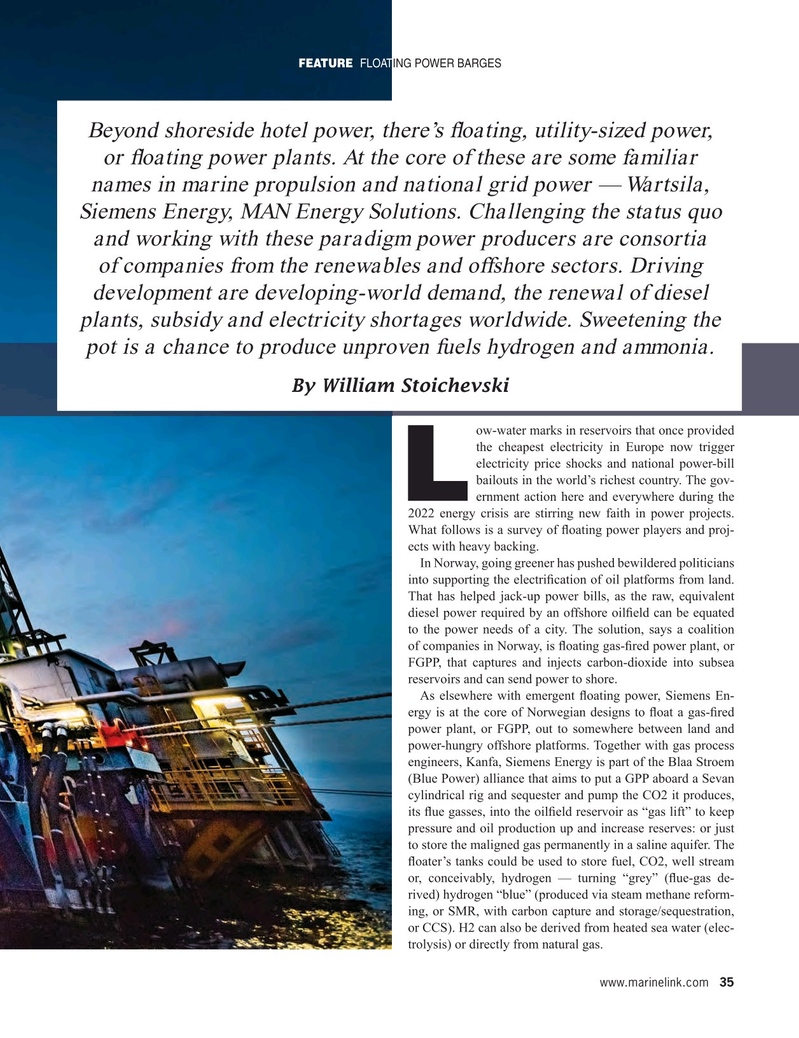
Page 35: of Maritime Reporter Magazine (November 2022)
The Workboat Edition
Read this page in Pdf, Flash or Html5 edition of November 2022 Maritime Reporter Magazine
FEATURE FLOATING POWER BARGES
Beyond shoreside hotel power, there’s ? oating, utility-sized power, or ? oating power plants. At the core of these are some familiar names in marine propulsion and national grid power — Wartsila,
Siemens Energy, MAN Energy Solutions. Challenging the status quo and working with these paradigm power producers are consortia of companies from the renewables and offshore sectors. Driving development are developing-world demand, the renewal of diesel plants, subsidy and electricity shortages worldwide. Sweetening the pot is a chance to produce unproven fuels hydrogen and ammonia.
By William Stoichevski ow-water marks in reservoirs that once provided the cheapest electricity in Europe now trigger electricity price shocks and national power-bill bailouts in the world’s richest country. The gov-
L ernment action here and everywhere during the 2022 energy crisis are stirring new faith in power projects.
What follows is a survey of ? oating power players and proj- ects with heavy backing.
In Norway, going greener has pushed bewildered politicians into supporting the electri? cation of oil platforms from land.
That has helped jack-up power bills, as the raw, equivalent diesel power required by an offshore oil? eld can be equated to the power needs of a city. The solution, says a coalition of companies in Norway, is ? oating gas-? red power plant, or
FGPP, that captures and injects carbon-dioxide into subsea reservoirs and can send power to shore.
As elsewhere with emergent ? oating power, Siemens En- ergy is at the core of Norwegian designs to ? oat a gas-? red power plant, or FGPP, out to somewhere between land and power-hungry offshore platforms. Together with gas process engineers, Kanfa, Siemens Energy is part of the Blaa Stroem (Blue Power) alliance that aims to put a GPP aboard a Sevan cylindrical rig and sequester and pump the CO2 it produces, its ? ue gasses, into the oil? eld reservoir as “gas lift” to keep pressure and oil production up and increase reserves: or just to store the maligned gas permanently in a saline aquifer. The ? oater’s tanks could be used to store fuel, CO2, well stream or, conceivably, hydrogen — turning “grey” (? ue-gas de- rived) hydrogen “blue” (produced via steam methane reform- ing, or SMR, with carbon capture and storage/sequestration, or CCS). H2 can also be derived from heated sea water (elec- trolysis) or directly from natural gas. www.marinelink.com 35
MR #11 (34-49).indd 35 11/4/2022 10:15:12 AM

 34
34

 36
36
